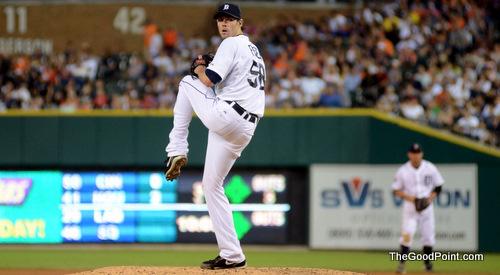
The evolution of Doug Fister
It wasn’t long ago when The Good Point caught up with Doug Fister after his first start with the Detroit Tigers following a midseason trade. He mentioned then that one of the first things he noticed upon arriving with the club was that his new teammates had a different fire in their eyes, that they truly wanted to compete.
If his two most recent postseason starts are any indication, it seems the feeling is contagious.
After leaving Game 1 of the ALDS with the bases loaded and two outs (only to see a grand slam balloon his pitching line), Fister took matters into his own hands in a decisive Game 5, throwing five innings of one-run ball as the Tigers went on to defeat the Yankees and earn an ALCS berth.
Soon after, however, they found themselves in a 2-0 hole heading back to Detroit for Game 3. Fortunately for his new club, Fister took control once again and allowed just two earned runs in seven-plus innings to help the Tigers claw their way back into the series.
For Fister, his October success is due to the strategy that helped him so much during the regular season.
“The mentality I take out there, [is] to try and get as much bad contact in the first three pitches of each hitter as possible,” Fister said shortly before the Tigers clinched home-field advantage in September. “It alleviates any unnecessary throws or anything we just need to minimize.”
While Fister seems to have stepped it up a notch after his Game 1 loss in the ALDS, he’s actually had that so called fire in his eyes ever since Spring Training, and it’s helped him improve upon his first full big league season in 2010.
One aspect of Fister’s game responsible for his breakout performance is the increased use of two off-speed pitches.
[php snippet=1]
After relying heavily on his fastball and changeup with the Seattle Mariners last year, Fister is now throwing those pitches less than ever before in favor of his slider and curveball. In fact, not only has Fister cut his changeup frequency in half from what it was only two years ago, he’s nearly doubled how often he uses both the slider and curveball.
The results from his more well-balanced arsenal speak for themselves, and through making various adjustments, he has actually upped the average velocity on all four of his pitches, too.
Fister attributes the results from his off-speed repertoire to increased confidence and simply keeping opposing hitters off-balance at the plate.
“Being able to throw any pitch in any count for a strike is a big thing,” he said. “Basically mixing pitches well, instead of any sort of pattern.”
More Tigers: The Rise of Max Scherzer | Alex Avila more confident in 2011
Along with the increased use off-speed pitches has come a willingness from opposing hitters to chase his offerings.
Though only a career-low 46 percent of Fister’s pitches finished in the strike zone this season, the deception from his off-speed pitches has fooled hitters into swinging at them as they venture out of the zone. It’s also helped him establish a new career-high of 6.1 strikeouts per nine innings, despite having never been known as a strikeout pitcher.
By pounding the zone with more first-pitch strikes and getting ahead in the count, Fister has gotten opposing hitters to swing at 37 percent of his pitches outside of it, which is a new career-high and almost double the mark that he put up with the Mariners in 2009.
“[I’m] really trying to get a hitter into swing mode, per se, then attack and kind of expand the strike zone,” the 6’8” right-hander said.
Perhaps the most drastic difference this season from Fister’s 2010 campaign is the way he pitched in August and September.
After opposing batters managed a .307 average and .752 OPS en route to a 4.98 ERA in his final 11 starts last season with Seattle, Fister actually pitched better this season as it wore on – and was utterly dominant from the moment he put on a Tigers jersey for the first time on August 3.
Fister was instrumental in helping the Tigers surge past division-rival Cleveland and win the AL Central division, going 8-1 with a 1.79 ERA in 10 starts for Detroit and limiting opposing hitters to a mere .206 average and .522 OPS. On top of notching more strikeouts and giving up less hits with Detroit than he did with Seattle, Fister walked just five batters in 70 innings with the Tigers.
For Fister, playing for the Tigers has exposed him to a completely different day-to-day culture, one he’s excited to be a part of for years to come.
“We come to the ballpark ready to win, ready to play, and ready to do whatever’s necessary to succeed,” Fister said. “That’s just the approach that we take every day.
“It’s a lot of fun playing here.”
[php snippet=1]

